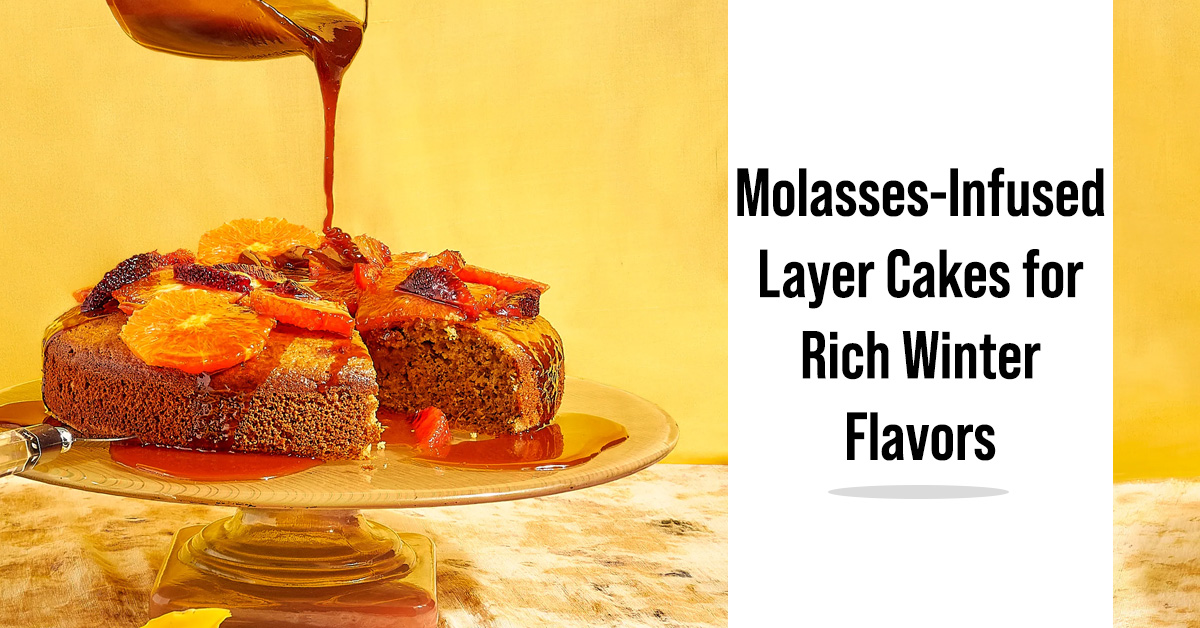Winter desserts call for flavors that feel grounding and warm. Lighter summer sweets rarely satisfy in this season; instead, bakers turn to ingredients that carry depth. Molasses belongs in that group. Its flavor is not simply sweet, it has a dark, slightly smoky character that lingers on the palate. For centuries it has been used in traditional recipes, from dense gingerbread loaves to spiced cookies and festive breads. When carried into layer cakes, molasses brings a different dimension. The sponge gains a richer color, the crumb stays moist longer, and the taste carries an earthy complexity that pairs naturally with winter spices. It takes a rustic ingredient and gives it a refined, modern showcase in layered form.
Why Molasses Defines Winter Baking
Molasses carries a flavor that feels made for cold weather. It’s heavy, almost smoky, with a sweetness that doesn’t fade quickly. There’s a faint bitterness too, the kind that makes spiced cakes feel more grown-up than sugary. That’s why it works so well with winter spices. Cinnamon and nutmeg echo its warmth, ginger cuts through the heaviness, and cloves deepen the background. Together they create the kind of flavors people expect around December tables.
Molasses keeps moisture locked in, so a cake baked in drier winter air won’t turn stiff the next day. That’s a difference bakers notice. If you compare, honey leans floral, maple syrup carries a lighter caramel note, but molasses stays earthy and bold. Refined sugar can only sweeten; molasses changes the character of the bake itself.
Choosing the Right Molasses for Layer Cakes
When bakers talk about molasses, they rarely mean just one thing. Light, dark, and blackstrap each bring a different personality to the mix, and the choice changes how a cake turns out. Light molasses is the mildest — sweet with only a hint of the smokiness that defines the ingredient. It works well in sponge layers where you want depth without losing balance. Dark molasses carries more weight. Its flavor is richer, with a stronger caramel tone that anchors many classic molasses cake recipes. For a dark molasses cake, this is the variety that gives the sponge its distinct flavor and deeper color. Blackstrap, the most intense, is robust, slightly bitter, and better suited for breads or dense spice cookies where its edge can be tamed. In layer cakes, dark molasses is the safer choice, giving structure and warmth without overwhelming the frosting or fillings layered on top.
Building Layers of Flavor in Cake
A layer cake is more than sponge stacked with cream. Each tier needs balance — sweetness from the crumb, spice in the background, texture from the filling or frosting. Molasses adds its mark in several ways. It can be baked directly into the sponge, giving color and depth. It can also appear in a spiced syrup brushed between layers to keep them moist. Some bakers even fold a small amount into buttercream for a subtle echo of the base.
Pairings matter. A molasses sponge with cream cheese frosting feels rich but not cloying. Chocolate ganache layered over an old-fashioned molasses cake creates a darker, almost smoky profile. Citrus can play a role too — grated orange zest or thin strips of candied peel lift the heaviness and bring freshness. What holds it together is proportion. Molasses carries strength, and too much can flatten other flavors. Used with restraint, it becomes the anchor, letting frosting, fillings, and spices each have their say while the cake holds together as a whole.
Step-by-Step Guide to a Molasses-Infused Winter Layer Cake
Baking with molasses calls for patience and precision, but the payoff is worth it. Start with the sponge. A mix of brown sugar and molasses gives the base its depth, richer than what plain sugar could ever provide. Cream the butter and sugar well before adding the molasses so the texture stays light. The batter should already carry that unmistakable aroma, a hint of smoke, a sweetness with weight behind it.
Spices come next. Cinnamon sets the warmth, nutmeg adds roundness, and ginger keeps the flavor lively. This combination is what transforms a simple molasses sponge into something closer to a gingerbread molasses cake or a festive spiced molasses cake. Measure carefully; too much spice can drown the subtle edge molasses brings.
Once baked, let the sponge cool completely before slicing. Even layers are key. Each one should be brushed with a molasses-spice syrup, thin enough to soak in but strong enough to add flavor. This step keeps the crumb moist, especially important for winter gatherings when cakes may sit longer before serving.
For frosting, cream cheese works beautifully against the richness, though whipped mascarpone or a light buttercream can also hold balance. Assembly should feel deliberate — no rush. Decorate with candied walnuts, dried cranberries, or curls of dark chocolate. These finishes not only add texture but also highlight the darker tones of the cake.
Why Bakers in Chennai Are Exploring Molasses Cakes
Chennai’s baking scene has changed a lot in recent years. Ten years ago, most bakeries stuck to plain sponges, simple pastries, and buttercream. Today, there’s demand for layered cakes with richer flavors, and molasses is one of the ingredients drawing attention. You now find jars in a handful of specialty stores, and baking schools have started using it in advanced classes.
The city doesn’t have a biting winter, so heavy puddings and fruitcakes aren’t everyday fare. But December feels different. Christmas and New Year parties create room for spiced bakes — cakes that carry cinnamon, nutmeg, and the depth of molasses. Students learning in cake baking classes in Velachery often encounter these recipes as part of their higher modules. It gives them exposure to ingredients that were once hard to find here and prepares them for a market that increasingly asks for more than just the familiar flavors.
Tips from Professionals for Perfect Results
Professional bakers handle molasses with care because small details change the outcome. Always measure it with a spoon brushed lightly with oil so it slides out clean. Use warm spices like cinnamon or ginger, but don’t overload; the balance between spice and sweetness matters more than quantity. Since molasses already adds depth, cut back the sugar a little to keep the cake from turning too heavy. Bake at a slightly lower temperature; it caramelizes quickly and can darken the sponge before the center sets. Let the cake rest overnight if possible. The flavor matures, a point often emphasized in cake baking classes in Anna Nagar.
Conclusion
Molasses in cake isn’t only about flavor. It carries the kind of history that people remember from older recipes passed around in families. Winter gives space for those deeper flavors. Nobody asks for light sponges in December; they want something with weight, something that lingers. Layer cakes make a good stage for it. Each tier can hold spice, cream, or fruit, but the molasses always comes through underneath. It changes a simple dessert into something that feels meant for the season. Rustic at its core, yet dressed enough to sit proudly on a festive table.


